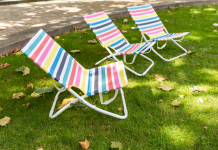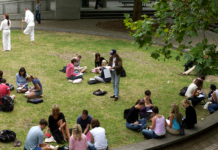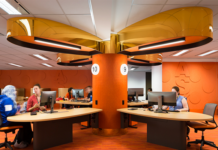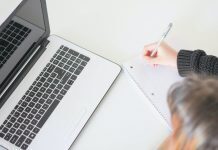Ever walk past those colourful helix statues wondering what’s happening inside the labs of the La Trobe Institute of Molecular Science (LIMS)? ‘Inside LIMS’ highlights the ground-breaking research happening on the top floors of our very own LIMS building, as well as revealing the stories of the staff and students behind the discoveries.
This week, MyLaTrobe’s Lakshmi Ganapathy speaks to Airah Javorsky, a third-year PhD student investigating the shape and interactivity of viruses (most recently COVID-19) under the supervision of Dr Marc Kvansakul.
So, let’s start with how you made it here – what brought you to LIMS?
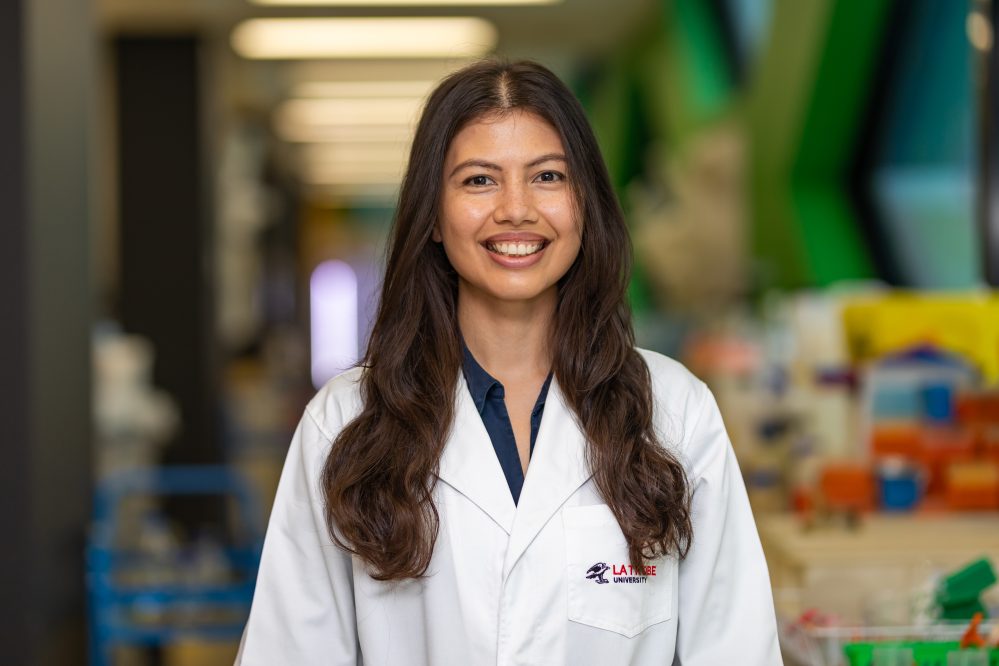
I did my undergrad here in Biomedical Science, and in my second year they were offering these summer scholarships to do research based mainly at LIMS…I managed to get one of those scholarships. I think it was just merit based; you apply and if your marks are good enough, they’ll select you.
I got into this particular lab with my [current] supervisor, Mark Kvansakul, and they sort of just showed me for about four weeks what a research environment was all about – we got to go into the lab and mix all these chemicals together and have a look at what little tiny proteins are doing. And I kind of really enjoyed that whole process, not only the procedure that scientists go through in the lab, but the critical thinking that’s involved, because you go step one, then [think about] how you get to step twelve, and then something goes wrong in the middle and you have to think [about] how to fix that.
I [hadn’t thought] about being a scientist, I was actually inspired to become a doctor. But after that experience, it just got me thinking, maybe lab work isn’t as monotonous as I thought it would be. So when my undergrad finished, I just applied to the same lab for my Honours…eventually I just liked the group so much and what I’m looking into that I also applied for my PhD with the same supervisor ’cause I really wanted to see how far this goes!
That sounds like a long time to be at LIMS! What’s kept you coming back?
I try not to think about how long I’ve been here! But when you’re preoccupied and you’re doing something you enjoy, obviously time flies, and you sort of just thrive in the environment.
I particularly like LIMS because it’s quite supportive. Everyone here is so friendly; people from other labs will not hesitate to strike [up] a conversation with you, and if you’re struggling trying to find the agents or chemicals, you can ask the guys next door and be like ‘hey, can I borrow some’ and they’d [say] ‘yeah sure, why not?!’ So, I think I just love how open and teaching friendly this place can be.
I’ve heard other institutions can be quite competitive, you know, ‘this is mine and I’m not going to share anything’, but LIMS is quite different. Everyone’s really open and just knows each other, and I really like that – hence why I stayed with the same group as well.
[Also] the boss relationship I have – [he’s] like a mentor. [He] just makes sure I’m okay, and even when things gets really stressful he’ll be there to try and help solve any problems. I think I knew that was a very important aspect moving up in my degrees, to have that good environment and not feel alone…to have others around you to jump ideas back and forth.
That sounds wonderful! So what’s an average day at LIMS like for you?
I’ll just [start with doing] some experimental work. So, I put on my lab coat, go into the lab, work on the pieces of equipment, put some reagents in…you see a whole bunch of people doing the same thing related to their research.
Once I’ve got a few experiments running, I can head back outside to my office and do a little bit of research, like papers that are related to what I’m doing, or write my little manuscript that helps in [writing] my thesis. It’s a lot of going to the desk [and] doing theoretic[al] stuff, going back into the lab and doing practical stuff, and just going back and forth.
I think especially now because it is a bit of a lockdown, everyone’s just focused on their own research. The whole collaborative space has [come to] a halt. We kind of look like little busy bees in the hive, just flapping around trying to get our work done!
That’s such a wholesome analogy! What’s your favourite part of being at LIMS?
Oh, that’s a toughie! Occasionally we’d have social gatherings…everyone [would] make teams of ten, and it would be like, a trivia night, and then there’d be little prizes, like free coffee in the agora if you win [or] some chocolates if [you’re] second…I think I have enjoyed that quite a lot.
You get to meet a lot of people that way, and it’s just…a fun activity to do. You walk by a lot of faces and sometimes you haven’t introduced yourself, but [at] these gatherings, you can finally say ‘I know you, I’ve seen you around’ and have a conversation…[learn] what they’re doing and why you see them around. So I think that’s my favourite, the trivia.
This one’s also a bit tough – what do you wish people knew about what you do in LIMS?
What do I wish people knew? We’re pretty hard working. I think you might assume academics sit at a desk and just read and be snobbish or whatever. But to be honest, to get as far as we can get you really have to push hard and be committed, which is a huge thing. So, I think I would like people to know that we’re not just trying to be clever people walking around knowing everything – we don’t. That’s why we’re here. That’s why we’re trying to do this research, and experiment.
Okay, let’s talk about your research. In lay person terms for our readers, what is it that you’re looking at?
I think I might have to use some analogies for this…a little cell is the basic block of our bodies…and our little cells need [to be] a particular shape. They can’t be like, fully triangular or square…they can’t be something that they were not supposed to be.
Viruses, they tend to invade these cells, our basic units, and when they invade…they sort of distort our cells to start replicating more viruses…So what I’ve seen is that when viruses change the shape of the cells, the cells can’t really maintain a proper environment…like a house [where the] architecture is completely distorted and everything inside is also quite distorted.
You’ve also been looking at COVID-19 recently, haven’t you?
Yeah…I came across it kind of randomly…because of this locKdown you can’t help but be curious – I’m looking at viruses, maybe COVID is one of those viruses that change the shape? I check it out and I’m like ‘oh, it does actually influence the shape’, [or] at least we saw in SARS-1. But it’s not clear if it change[s] shape in SARS-2…we got the samples of COVID and I had a look and it looked like yes, SARS-2 had also [used] the same mechanism.
In our lungs, there is a lining of skin epithelial cells that helps transfer oxygen into our blood…It’s this lining of the cell that COVID will continue to infect. When [it] attach[es] and distort[s] the shape, it also distort[s] the shape of other neighboring cells, and by doing so [it] can go into the bloodstream a lot more effectively so that barrier between the lungs and the body and the blood [is] found to be quite disrupted.
MERS actually showed not to do this…we found SARS-1 and 2 to be a lot more virulent than MERS, and this could potentially be the reason that it does damage the lining between the lung and the tissue a lot more in comparison.
What was it like doing the research?
When I first proposed it to my supervisor, he was like, ‘yeah, sure, why not go for it’…at first [I wasn’t] really seeing too [many] results [and I thought], ‘maybe this is like a dead-end project’, but then I finally got something.
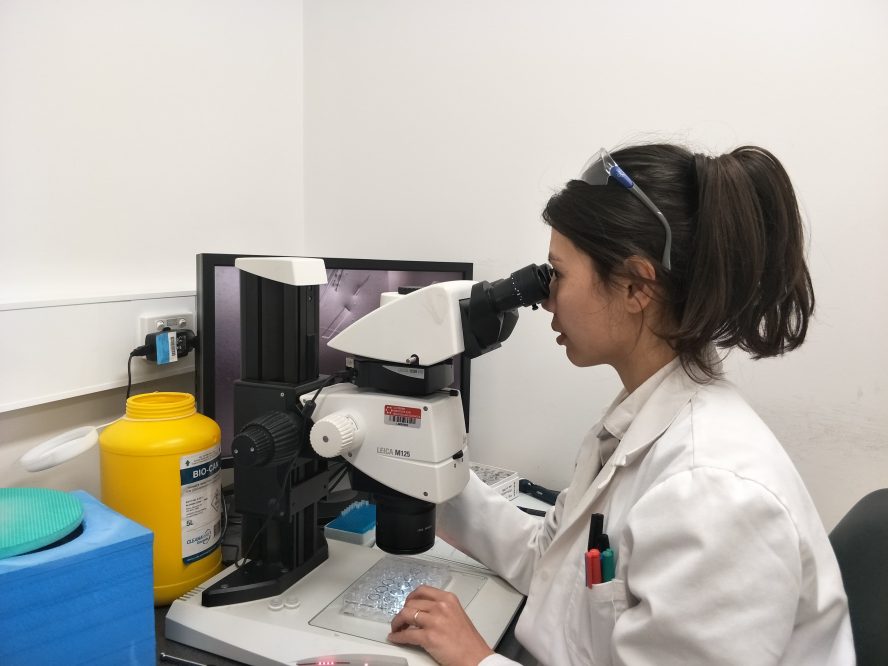
Then my supervisor [told me] there’s another group in America that want to publish something very similar to what we’re looking at. The choice was [to] try [and] finish this as soon as possible or just continue on [at] whatever pace you want, and I was like ‘I wanna finish this, I wanna publish this before this group does’…I was slaving away day and night [and] on weekends, just trying to make this data as clean [and] as clear as possible.
I was also writing the manuscript simultaneously, so sort of like flying the ship while building it at the same time, and I guess the people in LIMS just knew that I was really busy…if I needed to use any equipment, especially in my particular lab, they were more than willing to be like, ‘look you have a deadline, you use the equipment first’…I was pretty happy that I got that support from them, otherwise I don’t think we would have pushed to get that paper out the time that we wanted to.
Sounds like a very supportive lab and supervisor! What’s it like working with Dr Kvansakul?
Different supervisors have different styles. There will be some supervisors that just sort of, tell you what to do, and then there’ll be other supervisors who give you free reign to do whatever and try and make it work, and if [you] have problems they can come [supervise you].
My supervisor is somewhere in the middle. He is very supportive if you have a certain project idea, but you have to convince him that this is a project idea worth looking into. I have more responsibility for the project, which keeps me pretty motivated I suppose, but he will be there in my corner just to make sure everything’s steady and I’m not going in circles, ’cause in some cases when you are stuck and you cannot find a way, you definitely need someone with more experience to give you better suggestions.
I really enjoy how he’s quite positive; he always says ‘look, I know you can do this, and I know you’re fully capable of accomplishing this, here are my suggestions.’ I’ve never had a boss that would say all these things…I’ve always just had bosses [that say] ‘do this, do that’… [IT’S] really helped my confidence so I’m very grateful.
Sounds like you’ve gained a lot during your time here – what’s next?
Yeah, so obviously I have a few more papers to come out on those different viruses, and ’cause I’m in my third year I’m finishing up around June next year. I’m trying to publish those three papers so it can have a bigger impact on the academic community. Once that’s done, I guess my PhD is done and I’ll have to think about work prospects.
But in the meantime, I guess all the things that I learned by publishing that COVID paper I’m applying to these other papers that I’m trying to do. I realised what the actual steps are to publish something, because once you give it to an editor and then they have reviewers it goes through quite a process…I didn’t realise how long that process was, and how particular some reviewers can be, like, ‘this isn’t very clear.’ So now that I’m doing the current papers, I’m like, ‘okay, I know they said this wasn’t very clear last time, I’m going to really make it clear this time’ and just hopefully make that transition or that phrase a lot smoother.

